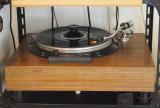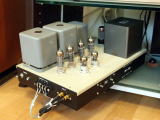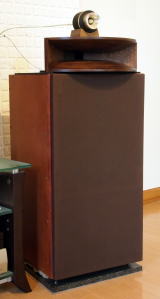Gaudi in 2015
2016/07/17 created
2021/05/07 updated
The contents of this page were reprinted from the previous homepage of mine, 'Tonochi's Audio Room'. Some parts were edited.
I have been developing my audio system Gaudi since 1974, but it is still
not completed yet. In November 2012, it became nearly what I had planned
in 1974 (block diagram), but it has been at a standstill since then. Completion of the midrange
amplifier MA-215 Arabesque will complete Gaudi at last. Though I finished
the design of MA-215 and purchased all the parts and materials for it,
I haven't begun building it.
The differences from the last year's Gaudi are removal of the FM/AM tuner
(SONY ST-S333ESJ) and change in the AC power connection.
[Block diagram]
I am suspending building the power amplifier MA-215 Arabesque, because,
as I explained on the page of Gaudi, I gave up completing Gaudi and began
designing Gaudi II. Anyway, the completion of MA-215 doesn't mean the completion
of Gaudi, because MA-215 is a solid state amp and it doesn't comply with
Gaudi's original system design where the preamp and all the power amplifiers
are tube type.
I am planning to build MA-215 in the near future, but I don't expect so
much, because It is the first solid state power amp I designed. I regard
it as a prototype of power amplifiers used in Gaudi II. I consider that
all the amplifiers in Gaudi II should be solid state type. I am going to
design superb amplifiers for Gaudi II based on MA-215 (I might use MA-215
in Gaudi II if it would be better than I expect).
I decided to get rid of the FM tuner from Gaudi to simplify the system.
Another reason is that FM broadcast, which was once called 'Music Wave',
became less attractive as non-musical programs such as talk programs or
even sports programs have outnumbered music programs.
I miss good-old-days FM broadcasting. My first step to build my own audio
system was obtaining a stereo FM radio at age of 13. I built a loudspeaker
system and connect it with the radio to accomplish a fairly good sound
quality. Since then, listening to FM has been a part of my daily life.
I've encountered many kinds of music I hadn't known before through FM.
From now on, I listen to FM with my second system in my study room.
For replay of music files, I continue to use the digital recorder KORG
MR-2000S as a digital player. As mentioned below, it sounds a little better
than before, though, the sound quality of CD spec files (44.1kHz/16bit
WAV) seems to be a bit worse than that of SONY SCD-555ES playing the original
CDs. In addition, MR-2000S does not accept long file names and file names
including 2-byte code, and it cannot replay compressed PCM files like FLAC
(only MP3 is OK). I need a digital player that can replay all sorts of
music files in high sound quality.
So far, SONY HAP-Z1ES is the one (as of January 2015). I auditioned it
at an audio shop where I am a regular customer. It sounded so good.
I have been evaluating PC-based audio system by using the USB DAC, KORG DS-DAC-10. I concluded the highest sound quality cannot be achieved with this kind of system, chiefly because PC is the source of electromagnetic and acoustical noises. I think I won't be satisfied even if I use more expensive USB DAC (I'll describe the details in the page of Misc Info later).
When I got rid of the FM tuner from Gaudi, I took the opportunity to check
the AC line connection.
First, I disconnected the power strip for TV and related devices from the
wall outlet for audio, and connected it to an ordinary wall outlet. These
devices are fully digital devices and don't need high quality AC line.
The power strip had been connected to the wall outlet for audio since me
and my wife moved to this house, when we had an analog TV.
Second, I connected KORG MR-2000S directly to the wall outlet for audio.
Until then, it was connected to the power strip for audio (Oyaide OCB-1).
Since the OCB-1 doesn't have an earthing wire, MR-2000S used to be floating
from the earth. However, the instruction manual of MR-2000S says it needs
earthing. It seems to have a power supply circuit without a transformer,
though this is not mentioned in the manual. I think this is the reason
why it needs earthing.
Earthing made MR-2000S sound a little better (the wall outlet for audio
has the earth pin).
Besides, I checked the connection of SCD-555ES and found it was connected
in the wrong polarity! It has been wrongly connected probably since 2004,
when the network CD-211 A-NET was installed. I corrected it and SCD-555ES
came to sound a little better. The sound images got sharper.
By the way, the instruction manual of SCD-555ES doesn't say anything about
the power line polarity. The instruction manual of ST-S333ESJ, which are
older and less expensive than SCD-555ES, even says the correct polarity
makes the sound quality better. Did the designer of SCD-555ES believe the
power line polarity wouldn't affect the sound quality?
[the current AC line connection]
Experts say that a device with larger power consumption should be connected
to an outlet nearer the switch board. But I have a different opinion. I
think the the current variation range of the device is more important than
the total power consumption.
The most power consuming device in Gaudi is the power amp for the woofers,
MA-201C. It is a push-pull tube amp. The current supplied from the power
supply circuitry to the output stage doesn't change so much, even when
the output power changes greatly. The output stage is nearly a constant
load viewed from the power supply circuitry. This is because the amp has
output transformers (detailed explanation is omitted here). The other stages
consumes only small power. In addition, MA-201C has ten tubes including
two rectifier tubes and the heaters consume more than 30% of the total
power consumption. The heater currents are constant regardless of change
of the output power.
The same goes for the power amp for the tweeters, MA-208.
The SACD player SCD-555E's power consumption is not large (21W), though,
it has servo-controlled motor and actuators in it and the current through
the power line changes impulsively. It turns into a noise in AC line by
the common impedance of the power line. It may affect the other devices
more seriously, because the noise is not related to the musical signals.
So I connected the SACD player directly to the wall outlet and the amplifiers
via the power strips.
Equipment
| Category | Model | Features | Description |
|---|---|---|---|
| ADP |  NOBODY PS-104 NOBODY PS-104 |
*Turntable: SONY TTS-8000 *Tone arm: GRACE G-1040 *Cartridge: audio-technica AT33PTG/II |
I've been using it w/o major modification since 1982. I changed the cartridge from MM type to MC type in 2014. I'll continue to use it as long as it works. |
| MC head amp |  NOBODY HA-213 NOBODY HA-213 |
Head amplifier for MC cartridges Gain = 30dB |
This amplifier was designed as a headphone amplifier at first. Before completion, it was re-designed as the MC head amplifier. Though its design is not perfect, a certain level of sound quality has been achieved. |
| DAP | SONY SCD-555ES | SACD/CD player | First generation SACD player. Also excellent as CD player having useful
features such as a digital filter selector. I've been using this since 2001. |
| DAP | Lenovo ThinkPad X121e | 11" laptop PC | Storage: 128GB SSD. The combination of this PC and DS-DAC-10 functions as digital audio player. It also functions as measurement instrument w/ PicoScope. |
| DAP | KORG DS-DAC-10 | USB DAC | The combination of this device and ThinkPad functions as digital audio player. The highest resolution is PCM 192kHz/24bit and DSD 5.6MHz. |
| DAR | KORG MR-2000S-BK | 1-bit digital recorder | Digital recorder for studio use. It is also available in the retail market.
The highest resolution is PCM 192kHz/24bit and DSD 5.6MHz. It is used for recording vinyl discs and playing hi-res music files. |
| Preamp |  NOBODY PA-210 Simplicity NOBODY PA-210 Simplicity |
Tube preamplifier All stages are SRPP CR-type phono equalizer Non-NFB flat stage Separate power supply |
A tube preamp made in 2001-2003. Featured by out-and-out simplicity and low noise. |
| Network |  NOBODY CD-211A A-NET NOBODY CD-211A A-NET |
Solid state Three-way channel divider (network) |
The first NOBODY-branded model that uses OP amps. Made in 2004. Revised
in 2012. Crossover frequencies: 800Hz(18dB/oct), 7200Hz(18dB/oct) |
| Tweeter amp |  NOBODY MA-208 NOBODY MA-208 |
Tube power amplifier 6BQ5 UL PP |
Designed for horn-loaded tweeters. Made in 1999. Split load phase splitter; rectifying tube. Output power: 10W+10W |
| Midrange amp | Flying Mole DAD-M100pro HT |
Mono digital power amplifier | Power amp for midrange. Warm sound like tube amp. Output power: 100W (8ohm) |
| Woofer amp | Tube power amplifier 6CA7 UL PP |
The first NOBODY-branded equipment, made in 1974. Used for woofers. The current revision: C Output power: 30W+30W | |
| Loudspeaker |  NOBODY SS-309A NOBODY SS-309A |
Three-way speaker system *Tweeter: Fostex T925A *Midrange: Fostex D1405+H400 *Woofer: Fostex FW305 |
12" woofer-based three-way loudspeaker, made in 2001. It doesn't include network and attenuator since it's designed for the multi-amplifier system. Vented box for woofer. The midrange unit was changed from full-range direct radiator to horn-loaded midrange in 2012 (Rev. A). |
| Pnono cable | PS-104 -> PA-210 | GRACE genuine cable (RCA plugs has been replaced) |
Low capacitance cable using LC-OFC. In 2011, the RCA plugs' solder joints corroded and the cable was disconnected. The RCA plugs were replaced with new ones using PTFE insulator. Sound quality has been a bit improved. |
| Line cable | SCD-555ES -> PA-210 | Handmade cable *Wire: BELDEN 8412 *Plug: Teflon RCA plug |
Handmade cable made of balanced type shield wire. Though the RCA plug is
a generic one, the insulator material is teflon. The plug's metal cover is not attached. Shrink tube is applied instead. |
| Line cable | PA-210 -> CD-211A | Handmade cable *Wire: BELDEN 8412 *Plug: Teflon RCA plug |
Handmade cable composed of balanced type shield wires. One end of the cable is soldered in CD-211A. |
| Line cable | CD-211A -> MA-208 | Handmade cable *Wire: BELDEN 8412 *Plug: Teflon RCA plug |
Handmade cable composed of balanced type shield wires. One end of the cable
is soldered in CD-211A. The wires were Audio Technica AT6A48 when CD-211 was built (2004). They were replaced with BELDEN 8412 in 2008. BELDEN is unquestionably superior. The metallic cover of the plug was replaced with a thermal shrink tube. |
| Line cable | CD-211A -> DAD-M100pro | Handmade cable *Wire: BELDEN 8412 *Plug: Teflon RCA plug |
Handmade cable composed of balanced type shield wires. One end of the cable is soldered in CD-211A. |
| Line cable | CD-211A -> MA-201C | Handmade cable *Wire: BELDEN 8412 *Teflon RCA plug |
Handmade cable composed of balanced type shield wires. One end of the cable is soldered in CD-211A. |
| Speaker cable | MA-208 -> SS-309A tweeter | Handmade cable *Wire: 47 Laboratory STRATOS *Plug: none |
Handmade cable made of 0.4mm copper single wires twisted at 30cm pitch. One end of the cable is soldered to the output terminal of MA-208. The other end is plated w/ silver loaded solder. |
| Speaker cable | DAD-M100pro -> SS-309A midrange | Handmade cable *Wire: 47 Laboratory STRATOS *Plug: banana plug for isntruments |
Handmade cable made of 0.4mm copper single wires twisted at 30cm pitch. Banana plugs for measurement instruments are attached to one end. The other end has no connector. |
| Speaker cable | MA-201C -> SS-309A woofer | Handmade cable *Wire: 47 Laboratory STRATOS *Plug: none |
Handmade cable made of 0.6mm copper single wires twisted at 30cm pitch. One end of the cable is soldered to the output terminal of MA-201C. The other end is directly soldered to the terminal of woofer. |
| Room | 25m2 living room | Fairly soundproofed. Slightly live at mid and high frequencies and slightly dead at low frequencies. Almost no standing waves thanks to the slant ceiling. Acoustics is tuned by using acoustic panels, sound absorbing panels and sound absorbing curtain. Equipped with outlets for audio equipment; both 100V and 200V. The sockets are for medical use. |